| Listing 1 - 10 of 38 | << page >> |
Sort by
|
Periodical
ISSN: 00222526 14679590 Publisher: Cambridge, Mass.
Abstract | Keywords | Export | Availability | Bookmark
 Loading...
Loading...Choose an application
- Reference Manager
- EndNote
- RefWorks (Direct export to RefWorks)
Mathematics --- Mathématiques --- Periodicals --- Périodiques --- Mathématiques --- Mathématique. --- Mathématique appliquée. --- 31.80 applications of mathematics --- Earth Sciences --- Mathematical Sciences --- Geophysics --- Applied Mathematics
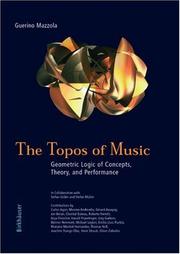
ISBN: 3764357312 3034894546 303488141X Year: 2002 Publisher: Basel Birkhäuser
Abstract | Keywords | Export | Availability | Bookmark
 Loading...
Loading...Choose an application
- Reference Manager
- EndNote
- RefWorks (Direct export to RefWorks)
Topos of Music is an extensive and elaborate body of mathematical investigations into music and involves several and ontologically different levels of musical description. Albeit the author Guerino Mazzola lists 17 contributors and 2 collaborators, the book should be characterized as a monograph. Large portions of the content represent original research of Mazzola himself, and the material from other work is exposed from Mazzola's point of view and is well referenced. The preface preintimates an intended double meaning of the term topos in the title. On the one hand, it provides a mathematical anchor, which is programmatic for the entire approach: the concept of a cartesian closed category with a subobject classifier. (...)Zentralblatt MATH.
Mathematical logic --- Music --- Mathematics --- Engineering & Applied Sciences --- Applied Mathematics --- Music theory --- Philosophy and aesthetics --- Applied mathematics. --- Engineering mathematics. --- Philosophy and science. --- Geometry. --- Algebraic geometry. --- Mathematics. --- Visualization. --- Applications of Mathematics. --- Philosophy of Science. --- Algebraic Geometry. --- Mathematics, general. --- Visualisation --- Imagination --- Visual perception --- Imagery (Psychology) --- Math --- Science --- Algebraic geometry --- Geometry --- Euclid's Elements --- Science and philosophy --- Engineering --- Engineering analysis --- Mathematical analysis
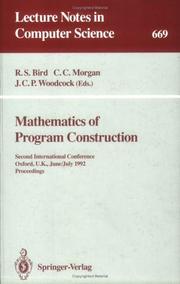
ISBN: 3540566252 0387566252 354047613X Year: 1993 Volume: vol 669 Publisher: Berlin : Springer-Verlag,
Abstract | Keywords | Export | Availability | Bookmark
 Loading...
Loading...Choose an application
- Reference Manager
- EndNote
- RefWorks (Direct export to RefWorks)
Not very long ago, the uninhibited use of mathematics in the development of software was regarded as something for academics alone. Today, there is moreand more interest from industry in formal methods based on mathematics. This interest has come from the success of a number of experiments on real industrial applications. Thus, there is not only a belief, but also evidence, that the study of computer programs as mathematical objects leads to more efficient methods for constructing them. The papers in this volume were presented at the Second International Conference on the Mathematics of Program Construction, held at St. Catherine's College, Oxford, June 29 - July 3, 1992. The conference was organized by the Oxford University Programming Research Group, and continued the theme set by the first - the use of crisp, clear mathematics in the discovery and design of algorithms. The second conference gives evidence of the ever-widening impact of precise mathematical methods in program development. There are papers applying mathematics not only to sequential programs but also to parallel and on-current applications, real-time and reactive systems, and to designs realised directly in hardware. The volume includes 5 invited papers and 19 contributed papers.
Electronic digital computers --- Programming --- Congresses --- Computer science --- Mathematics --- Electronic digital computers - Programming - Congresses. --- Computer science - Mathematics - Congresses. --- Software engineering. --- Information theory. --- Mathematics. --- Computer science. --- Computer software. --- Software Engineering/Programming and Operating Systems. --- Theory of Computation. --- Applications of Mathematics. --- Programming Techniques. --- Software Engineering. --- Algorithm Analysis and Problem Complexity. --- Software, Computer --- Computer systems --- Informatics --- Science --- Math --- Communication theory --- Communication --- Cybernetics --- Computer software engineering --- Engineering
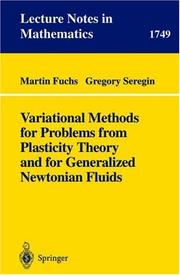
ISBN: 3540413979 3540444424 9783540413974 Year: 2000 Volume: 1749 Publisher: Berlin ; Heidelberg ; New York Springer Verlag
Abstract | Keywords | Export | Availability | Bookmark
 Loading...
Loading...Choose an application
- Reference Manager
- EndNote
- RefWorks (Direct export to RefWorks)
Variational methods are applied to prove the existence of weak solutions for boundary value problems from the deformation theory of plasticity as well as for the slow, steady state flow of generalized Newtonian fluids including the Bingham and Prandtl-Eyring model. For perfect plasticity the role of the stress tensor is emphasized by studying the dual variational problem in appropriate function spaces. The main results describe the analytic properties of weak solutions, e.g. differentiability of velocity fields and continuity of stresses. The monograph addresses researchers and graduate students interested in applications of variational and PDE methods in the mechanics of solids and fluids.
Plasticity. --- Newtonian fluids. --- Calculus of variations. --- Calcul des variations --- Calculus of variations --- Newtonian fluids --- Plasticiteit --- Plasticity --- Plasticité --- Variatieberekening --- Applied mathematics. --- Engineering mathematics. --- Mechanics. --- Mathematical physics. --- Partial differential equations. --- Applications of Mathematics. --- Classical Mechanics. --- Theoretical, Mathematical and Computational Physics. --- Partial Differential Equations. --- Partial differential equations --- Physical mathematics --- Physics --- Classical mechanics --- Newtonian mechanics --- Dynamics --- Quantum theory --- Engineering --- Engineering analysis --- Mathematical analysis --- Mathematics
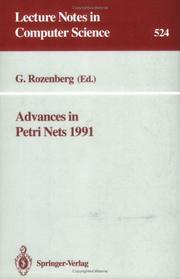
ISBN: 3540543988 0387543988 3540476008 Year: 1991 Volume: 524 Publisher: Berlin Springer
Abstract | Keywords | Export | Availability | Bookmark
 Loading...
Loading...Choose an application
- Reference Manager
- EndNote
- RefWorks (Direct export to RefWorks)
The main idea behind the series of volumes Advances in Petri Nets is to present to the general computer science community recent results which are the most representative and significant for the development of the area. Thepapers for the volumes are drawn mainly from the annual International Conferences on Applications and Theory of Petri Nets. Selected papers from the latest conference are independently refereed, and revised and extended as necessary. Some further papers submitted directly to the editor are included. Advances in Petri Nets 1991 covers the 11th International Conference on Applications and Theory of Petri Nets held in Paris, France in June 1991. The volume contains the Bibliography of Petri Nets 1990 prepared by H. Pl}nnecke and W. Reisig, with over 4000 entries.
Computer architecture. Operating systems --- Petri nets --- Machine theory --- Réseaux de Pétri --- Automates mathématiques, Théorie des --- Congresses --- Congrès --- Réseaux de Pétri --- Automates mathématiques, Théorie des --- Congrès --- Computer science. --- Computer Communication Networks. --- Mathematics. --- Computer software. --- Logic design. --- Computation by Abstract Devices. --- Applications of Mathematics. --- Algorithm Analysis and Problem Complexity. --- Logics and Meanings of Programs. --- Processor Architectures. --- Design, Logic --- Design of logic systems --- Digital electronics --- Electronic circuit design --- Logic circuits --- Switching theory --- Software, Computer --- Computer systems --- Math --- Science --- Informatics

ISBN: 3540594086 0387594086 3540492453 9780387594088 9783540594086 Year: 1995 Volume: 920 Publisher: Berlin : Springer-Verlag,
Abstract | Keywords | Export | Availability | Bookmark
 Loading...
Loading...Choose an application
- Reference Manager
- EndNote
- RefWorks (Direct export to RefWorks)
This volume constitutes the proceedings of the Fourth International Conference on Integer Programming and Combinatorial Optimization, IPCO '95, held in Copenhagen in May 1995 under the sponsorship of the Mathematical Programming Society. Integer programming and combinatorial optimization provide a fruitful theoretical and algorithmic basis for the solution of a number of optimization problems occuring in real-world situations, such as production planning and scheduling, routing, crew scheduling, or network construction. This volume presents 36 revised papers selected from a total of 105 submissions and offers a representative up-to-date snapshot on the state of the art in this interdisciplinary area of research and applications.
Integer programming --- Combinatorial optimization --- Programmation en nombres entiers --- Optimisation combinatoire --- Congresses. --- Congrès --- Congresses --- Congrès --- Information theory. --- Distribution (Probability theory. --- Mathematics. --- Computer software. --- Numerical analysis. --- Combinatorics. --- Theory of Computation. --- Probability Theory and Stochastic Processes. --- Applications of Mathematics. --- Algorithm Analysis and Problem Complexity. --- Numerical Analysis. --- Combinatorics --- Algebra --- Mathematical analysis --- Software, Computer --- Computer systems --- Math --- Science --- Distribution functions --- Frequency distribution --- Characteristic functions --- Probabilities --- Communication theory --- Communication --- Cybernetics --- Integer programming - Congresses --- Combinatorial optimization - Congresses
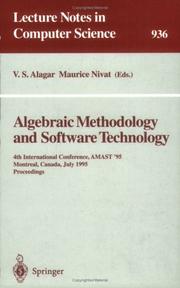
ISBN: 3540600434 3540494103 9783540600435 Year: 1995 Volume: 936 Publisher: Berlin : Springer-Verlag,
Abstract | Keywords | Export | Availability | Bookmark
 Loading...
Loading...Choose an application
- Reference Manager
- EndNote
- RefWorks (Direct export to RefWorks)
This volume constitutes the proceedings of the 4th International Conference on Algebraic Methodology and Software Technology, held in Montreal, Canada in July 1995. It includes full papers or extended abstracts of the invited talks, refereed selected contributions, and research prototype tools. The invited speakers are David Gries, Jeanette Wing, Dan Craigen, Ted Ralston, Ewa Orlowska, Krzysztof Apt, Joseph Goguen, and Rohit Parikh. The 29 refereed papers presented were selected from some 100 submissions; they are organized in sections on algebraic and logical foundations, concurrent and reactive systems, software technology, logic programming and databases.
Software engineering --- Abstract data types (Computer science) --- Congresses. --- Congresses --- Information theory. --- Software engineering. --- Mathematics. --- Logic design. --- Computer science. --- Theory of Computation. --- Software Engineering/Programming and Operating Systems. --- Applications of Mathematics. --- Logics and Meanings of Programs. --- Mathematical Logic and Formal Languages. --- Software Engineering. --- Math --- Science --- Informatics --- Design, Logic --- Design of logic systems --- Digital electronics --- Electronic circuit design --- Logic circuits --- Machine theory --- Switching theory --- Computer software engineering --- Engineering --- Communication theory --- Communication --- Cybernetics --- Software engineering - Congresses. --- Abstract data types (Computer science) - Congresses
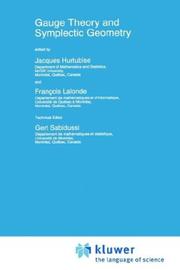
ISBN: 0792345002 9048148308 9401716676 9780792345008 Year: 1997 Volume: 488
Abstract | Keywords | Export | Availability | Bookmark
 Loading...
Loading...Choose an application
- Reference Manager
- EndNote
- RefWorks (Direct export to RefWorks)
Gauge theory, symplectic geometry and symplectic topology are important areas at the crossroads of several mathematical disciplines. The present book, with expertly written surveys of recent developments in these areas, includes some of the first expository material of Seiberg-Witten theory, which has revolutionised the subjects since its introduction in late 1994. Topics covered include: introductions to Seiberg-Witten theory, to applications of the S-W theory to four-dimensional manifold topology, and to the classification of symplectic manifolds; an introduction to the theory of pseudo-holomorphic curves and to quantum cohomology; algebraically integrable Hamiltonian systems and moduli spaces; the stable topology of gauge theory, Morse-Floer theory; pseudo-convexity and its relations to symplectic geometry; generating functions; Frobenius manifolds and topological quantum field theory.
Integral geometry. --- Symplectic manifolds. --- Gauge fields (Physics) --- Mathematical physics --- Mathematics. --- Mathematics --- Congresses --- Differential geometry. --- Algebraic topology. --- Global analysis (Mathematics). --- Manifolds (Mathematics). --- Applied mathematics. --- Engineering mathematics. --- Partial differential equations. --- Differential Geometry. --- Algebraic Topology. --- Global Analysis and Analysis on Manifolds. --- Applications of Mathematics. --- Partial Differential Equations. --- Partial differential equations --- Engineering --- Engineering analysis --- Mathematical analysis --- Geometry, Differential --- Topology --- Analysis, Global (Mathematics) --- Differential topology --- Functions of complex variables --- Geometry, Algebraic --- Differential geometry --- Gauge fields (Physics) - Mathematics.
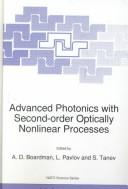
ISBN: 0792353153 0792353161 9400708505 Year: 1998 Volume: 61 Publisher: Kluwer,
Abstract | Keywords | Export | Availability | Bookmark
 Loading...
Loading...Choose an application
- Reference Manager
- EndNote
- RefWorks (Direct export to RefWorks)
Although it took some time to establish the word, photonics is both widely accepted and used throughout the world and a major area of activity concerns nonlinear materials. In these the nonlinearity mainly arises from second-order or third-order nonlinear optical processes. A restriction is that second-order processes only occur in media that do not possess a centre of symmetry. Optical fibres, on the other hand, being made of silica glass, created by fusing SiO molecules, are made of material with a centre of z symmetry, so the bulk of all processes are governed by third-order nonlinearity. Indeed, optical fibre nonlinearities have been extensively studied for the last thirty years and can be truly hailed as a success story of nonlinear optics. In fact, the fabrication ofsuch fibres, and the exploitation oftheir nonlinearity, is in an advanced stage - not least being their capacity to sustain envelope solitons. What then ofsecond-order nonlinearity? This is also well-known for its connection to second-harmonic generation. It is an immediate concern, however, to understand how waves can mix and conserve both energy and momentum ofthe photons involved. The problem is that the wave vectors cannot be made to match without a great deal of effort, or at least some clever arrangement has to be made - a special geometry, or crystal arrangement. The whole business is called phase matching and an inspection ofthe state-of-the-art today, reveals the subject to be in an advanced state.
Optics. --- Electrodynamics. --- Lasers. --- Photonics. --- Materials science. --- Applied mathematics. --- Engineering mathematics. --- Classical Electrodynamics. --- Optics, Lasers, Photonics, Optical Devices. --- Characterization and Evaluation of Materials. --- Applications of Mathematics. --- Engineering --- Engineering analysis --- Mathematical analysis --- Material science --- Physical sciences --- New optics --- Optics --- Light amplification by stimulated emission of radiation --- Masers, Optical --- Optical masers --- Light amplifiers --- Light sources --- Optoelectronic devices --- Nonlinear optics --- Optical parametric oscillators --- Dynamics --- Physics --- Light --- Mathematics --- Nonlinear optical materials --- Photonics
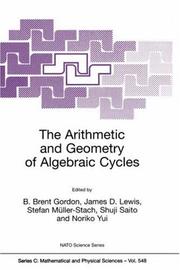
ISBN: 0792361938 0792361946 9401140987 Year: 2000 Volume: 548
Abstract | Keywords | Export | Availability | Bookmark
 Loading...
Loading...Choose an application
- Reference Manager
- EndNote
- RefWorks (Direct export to RefWorks)
The NATO Advanced Study Institute on "The Arithmetic and Geometry of Algebraic Cycles" was held at the Banff Centre for Conferences in Banff (Al berta, Canada) from June 7 until June 19, 1998. This meeting was organized jointly with Centre de Recherches Mathematiques (CRM), Montreal, as one of the CRM Summer schools which take place annually at the Banff Center. The conference also served as the kick-off activity of the CRM 1998-99 theme year on Number Theory and Arithmetic Geometry. There were 109 participants who came from 17 countries: Belgium, Canada, China, France, Germany, Greece, India, Italy, Japan, Mexico, Netherlands, - mania, Russia, Spain, Switzerland, the United Kingdom and the United States. During a period of two weeks, 41 invited lectures and 20 contributed lec tures were presented. Four lectures by invited speakers were delivered every day, followed by two sessions of contributed talks. Many informal discussions and working sessions involving small groups were organized by individual partic ipants. In addition, participants' reprints and preprints were displayed through out in a lounge next to the auditorium, which further enhanced opportunities for communication and interaction.
Mathematics --- Physical Sciences & Mathematics --- Geometry --- Geometry, algebraic. --- K-theory. --- Field theory (Physics). --- Mathematics. --- Global analysis. --- Algebraic Geometry. --- K-Theory. --- Field Theory and Polynomials. --- Applications of Mathematics. --- Global Analysis and Analysis on Manifolds. --- Math --- Science --- Classical field theory --- Continuum physics --- Physics --- Continuum mechanics --- Algebraic topology --- Homology theory --- Algebraic geometry --- Algebraic geometry. --- Algebra. --- Applied mathematics. --- Engineering mathematics. --- Global analysis (Mathematics). --- Manifolds (Mathematics). --- Geometry, Differential --- Topology --- Analysis, Global (Mathematics) --- Differential topology --- Functions of complex variables --- Geometry, Algebraic --- Engineering --- Engineering analysis --- Mathematical analysis
| Listing 1 - 10 of 38 | << page >> |
Sort by
|

 Search
Search Feedback
Feedback About UniCat
About UniCat  Help
Help News
News